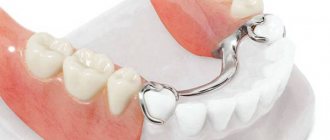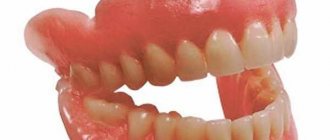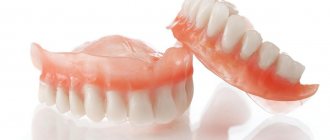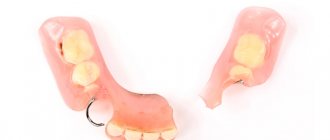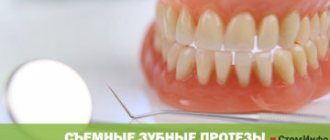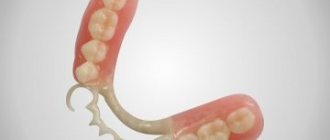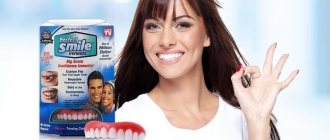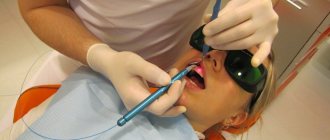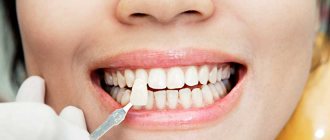A new generation prosthesis without a palate - what is its main feature
According to reviews from patients who use conventional removable appliances, most experience certain difficulties with eating and many experience inflammatory processes in the soft tissues of the oral cavity. In addition, traditional dentures with a palatal bridge block about 40% of taste buds, which is why a person loses the opportunity to fully enjoy the taste of his favorite dishes1.
Such dentures are more comfortable to wear
But thanks to new technologies, today manufacturers of removable tooth-replacing structures have reached a qualitatively new level, presenting the world with modern, improved models. Such products are slightly smaller in size than traditional systems, but their main feature is the absence of a palatal septum. They provide a more uniform distribution of the chewing load, are characterized by increased comfort and reliability of fastening.
Advantages and disadvantages
Among the main advantages of palatalless designs are:
- no need to grind teeth;
- comfort while wearing;
- lack of sensation of the presence of a foreign body in the oral cavity;
- high aesthetics;
- short period of adaptation;
- no increased salivation
- correct distribution of chewing load;
- no rubbing of soft tissues;
- reliable fixation in the mouth;
- no problems with speech function;
- affordable price;
- no dietary restrictions;
- the ability to wear the structure during periodontitis;
- no need to remove the product at night.
A prosthesis without a palate does not distort the perception of taste, since it does not block the taste buds that are located on the palate.
Compared to the advantages, the number of disadvantages of the designs is minimal. They can be fixed only to abutment teeth (with preliminary preparation). They require increased attention. Among the basic principles of care are systematicity, accuracy, selection of suitable products and visits to the dental office every six months.
After installation, it is necessary to regularly clean the structure (twice a day) with a special soft brush and paste. Additionally, it is recommended to rinse your mouth after every meal. Storage of products must be carried out strictly according to the instructions of the orthopedic doctor.
Design features and key characteristics
Regardless of what material was used to create the orthopedic device, all new generation products have approximately the same configuration. So, the prosthesis consists of the following elements:
- Plastic Gum – The base is light pink in color and is usually created from acrylic, nylon or other elastic materials. In fact, this is a part that imitates natural gums and is designed to fully restore the aesthetic appearance of a smile,
- artificial crowns - usually made of plastic, metal-plastic ceramics or aesthetic zirconium,
- retainers are fastening elements that ensure reliable retention of the system in the oral cavity. Their role can be played by special metal or plastic hooks (clasps) or locks (attachments). The latter are a system, part of which is attached to the roots of living teeth, and the second - inside the base. In models designed for complete replacement of the dentition, there are no fastening elements, and fixation is achieved through suction to the gums or attachment to implants, if the choice falls on this method of restoration.
The design consists of artificial gums, crowns and retainers.
For removable prosthetics, you will have to visit a specialist’s office 2-3 times, of course, if there is no need to treat concomitant inflammatory diseases.
At the first examination, the doctor will assess the current condition of the oral cavity, examine the x-ray image and suggest the optimal model for your specific case. Next, he will take impressions and forward them to the dental laboratory. After this, you will need to visit a specialist to try on the finished product. It may need to be adjusted and more accurately adjusted to the anatomical features of the jaw apparatus. Only after this is final fixation of the prosthetic device possible.
Overview characteristics
Orthopedic products without a palate are a bridge-like structure made in the form of a chain of analogue teeth installed on a base. The products are compact in size, lightweight, and have increased strength.
Before installing such orthopedic products, it is necessary that the patient has supports on the jaw, and it does not matter whether these are natural healthy elements of the jaw arch, roots secured with pins or implants.
These models of dentures differ from false jaws in that they do not have a plastic plate covering the palate. They are made from innovative synthetic materials that give the product a natural look:
- Acrylic. It is especially popular among patients for its reliability and sufficient strength.
- Nylon . Lightweight and elastic material, hypoallergenic and easy to use.
- Polyurethane . A soft material that is in demand in dental practice for its flexibility, strength and affordable cost.
For reference! It has been proven that with traditional removable dentures, 60% of surveyed patients cannot chew food thoroughly, and 40% suffer from persistent gum problems and various dental diseases.
Also, during operation, 50% of owners of structures that block the sky do not fully feel the taste of food. The development of innovative systems helped to avoid negative feelings.
The products have a number of obvious advantages:
- wearing comfort;
- quick period of adaptation;
- stable and durable installation;
- no risk of developing hypersalivation (increased salivation);
- uniform distribution of chewing pressure;
- normal tissue perception of a foreign body in the mouth (without vomiting and nausea);
- the possibility of nutritious food;
- affordable price;
- design versatility;
- optimal aesthetics;
- immobilization of teeth (splinting effect), which allows people with weakened dental ligaments to wear a prosthesis;
- Replacing one or more elements does not require changing the entire prosthesis.
Some models of structures without a palate are not removed during night sleep (you can forget about ridicule about the jaw in the glass).
Among the disadvantages it is worth highlighting:
- the need for supporting teeth and their preparation for installation of the structure;
- special hygiene care.
Remarkable! The systems under consideration may slightly change the contours of the face during wear.
Which removable dentures are best to install in case of partial absence of teeth?
Come here to take a closer look at the design of the Deflex prosthesis.
At this address https://zubovv.ru/protezirovanie/semnyie-p/chetyire-provokatora-allergii.html we will talk about the symptoms of allergies to dentures.
Indications and contraindications for removable prosthetics
Removable prosthetics allows you to solve various clinical problems. Here are the main indications for the installation of new generation orthopedic devices:
- partial edentia or absence of part of the teeth on the jaw,
- complete toothlessness,
- the presence of not too pronounced inflammatory processes in soft tissues,
- impossibility of implantation due to certain reasons or lack of financial capabilities,
- temporary replacement of teeth until the permanent structure or osseointegration of implanted implants is ready.
Complete absence of teeth is an indication for prosthetics.
But this option for restoring a smile is not suitable for all patients. So, for example, among the contraindications to removable prosthetics, experts in the field of dental orthopedics primarily highlight acute inflammatory processes and allergies to the materials used. In addition, certain varieties cannot be fixed in the absence of supporting teeth - they are only suitable for partial restoration of a row.
And another important nuance: even if the product does not involve a partition on the upper jaw, it still slightly overlaps the palate, which causes some inconvenience. Therefore, the best way to restore teeth is still implantation. With the advent of one-stage treatment protocols, complete jaw restoration has become faster and more accessible to a wide range of patients, but first things first.
Reviews
Modern dental orthopedics has made a great leap forward, developing and introducing into practice a new generation of prostheses without a palate.
Convenient and aesthetic designs make it possible to eliminate most defects in the dentition, fully restore chewing functions and return the patient to a beautiful smile.
We will be glad to see your feedback on the designs discussed in the article. You can leave your entry in the “comments” section.
If you find an error, please select a piece of text and press Ctrl+Enter.
Tags: removable dentures
Did you like the article? stay tuned
No comments yet
Types of removable products without palate
Modern new generation systems, including those without a sky, are created primarily from hypoallergenic materials. A wide range of available solutions allows you to choose the option that is most suitable for each individual case. Let's look at the main types of removable dentures without a palate.
Clasp designs
The set of clasp dentures includes a metal arch, also known as a clasp. Essentially, it is the basis for acrylic gums and artificial crowns. Such a denture is designed for only partial replacement, since its fixation requires at least two supporting elements in the form of living teeth or implants. There is also a separate type of clasp design with special claw-shaped retainers for loose teeth.
“I’m also now slowly restoring my teeth on both jaws. So far I have managed to get the entire lower row of teeth placed on implants. There is a clasp design on the upper jaw - an excellent solution. Much better than the dentures I used to wear. With such dentures, you can wait a little longer to save up for implantation. If you are choosing between removable solutions, pay attention to this option...”
Nikolay Os., Magnitogorsk, from correspondence on the forum www.32top.ru
The part that imitates gums is usually created from acrylic of a sufficient degree of plasticity, the crowns are made from metal-plastic, ceramics or zirconium. Based on the type of fastening, the following variations of clasp orthopedic systems are distinguished:
- on hooks (clasps) - a common option, affordable. Allows you to more evenly distribute the chewing load, lacks a palatal bridge on the upper jaw, although it still slightly overlaps the palate. But metal hooks can be noticeable against the background of the natural color of the enamel, so this option is preferable for cases when it is necessary to replace a large number of teeth at once, so that the hooks are located on the sides and do not fall into the smile area,
Clasp dentures with clasps - with a locking type of fastening (on attachments) - a more expensive, but at the same time comfortable solution. Part of the fastening system is installed inside the support element, while the second is located in the base. At the moment of fixation, the two elements literally snap together, ensuring reliable retention in the oral cavity,
Clasp dentures with locks - on telescopic crowns - an even more expensive option, which requires at least two healthy supporting teeth on the sides. Installation of such a design involves preparing the supporting elements and fixing special metal caps on them. The prosthesis itself contains hollow crowns that are placed on top of metal tips. This method of fixation is considered the most reliable and comfortable for the patient.
The photo shows dentures on telescopic crowns
Clasp structures are conditionally removable systems - a dentist can remove them, while it is not recommended to try to remove the device from the oral cavity on your own. Adaptation to such a prosthesis usually takes about 2 weeks, and its service life can reach 10 years or more.
"Quattro Ti" made of elastic material Dental D
“Quadrotti” prostheses, developed by Italian specialists, belong to a separate category of clasp devices. True, they do not contain metal components, which improves aesthetic characteristics and expands the possibilities for solving various clinical problems. This system also has an arched shape, but the product covers only part of the gum, practically not covering the palate. It is created on the basis of Dental D material - quite elastic and at the same time resistant to increased chewing loads. However, such tooth-replacement devices are intended only for partially removable prosthetics.
The product includes elastic artificial gum in a light pink shade, artificial crowns and elastic hooks for fixation on supporting elements. The latter can be white or pink, and also be completely transparent. The prosthesis itself is smaller in size, and its service life is 7-10 years - with proper care and respect.
Designs with locks or attachments
Today, models with attachments instead of hooks are also widely used. We have already discussed various types of removable systems with such fastening, but it is worth considering this prosthetic option separately. So, inside the dental roots there is a stump tab or abutment with a spherical top. The second part of the attachment is located at the base, under the artificial gum. These two elements snap together, ensuring reliable fastening of the entire structure.
Models with attachments instead of hooks
At the same time, there is no palatal bridge, which generally increases the degree of comfort while wearing such systems. This is a variant of conditionally removable prosthetics - as in the case of a clasp design, only a dentist can remove the product. The service life of this design is 5-7 years.
Sandwich prosthesis - design features
The prosthetic design provides hollow crowns along the edges, which are literally put on the supporting teeth. To use this design, it is important that at least two living teeth are preserved in the distal sections. The sandwich denture also implies the absence of too massive palatal overlap, which somewhat increases the comfort while wearing it. The service life of such a product can reach 10 years or more, but much in this matter will depend on the care of new teeth and the oral cavity as a whole.
Sandwich prosthesis is attached to your own teeth
Temporary immediate prosthesis (“butterfly”)
A temporary structure that is fixed until the permanent product is ready or until the implants take root. Operational period - from 2 weeks to six months. To create such products, lightweight materials are used. An immediate prosthesis involves the presence of elastic hooks on the sides, which are attached to elements adjacent to the defect. If we are talking about complete restoration of the dentition, then the device is fixed due to a tight fit and suction to the gum. But such prostheses are used only as a temporary solution; they cannot provide the proper level of comfort and strength of fixation, especially in the case of complete restoration of the row.
The photo shows a butterfly prosthesis
Kinds
There are several types of innovative designs. They are selected depending on the number and location of teeth. They differ in materials of manufacture, fastening elements, service life and other characteristics.
Thanks to modern technologies, it is possible to obtain products of high strength and aesthetics using individual casts. The following varieties are distinguished:
- acrylic,
- nylon,
- sandwich (quadrotti),
- Acry-free,
- clasp,
- telescopic.
Let's take a closer look at each type of new generation product separately.
Acrylic dentures are affordable, but not very practical to wear
Acrylic
This is the simplest prosthesis of the new generation. It has a number of disadvantages, due to which it is not in great demand among patients. The acrylic construction is characterized by a lack of elasticity. It rubs soft tissues and mucous membranes, is often accompanied by painful sensations when worn, and can impair diction.
Due to regular use, it often leads to gum atrophy. Some patients have an allergic reaction to acrylic. When chewing hard foods, they can become deformed.
Service life – 5 years. The main advantage is low price. The average cost of an acrylic prosthesis is 14,000 – 16,000 rubles.
Nylon
These are soft dentures that are elastic. They are highly durable and resistant to various negative influences. Due to the elasticity, the likelihood of damage to the dentures is minimized.
Nylon dentures are elastic and do not rub the mucous membrane
The advantages of nylon construction include the absence of allergic reactions (due to the fact that there are no metal or acrylic elements) and high aesthetics (do not differ from natural teeth).
It is fixed in the oral cavity using the suction method. A denture is used to replace one or more teeth in any jaw. The service life, subject to proper care, is 6-7 years.
This design will be more expensive compared to acrylic dentures. The average cost of a nylon prosthesis is 24,000 – 26,000 rubles.
Sandwich (quadrotti)
A distinctive feature of sandwich dentures is that there is no need to remove them at night. As a rule, they are made from a combination of two materials - acrylic and nylon. The product consists of a number of teeth, some of which are made in the form of artificial crowns that can be placed on the patient’s teeth.
The design consists of two parts - flexible gums and soft hooks for fixation. It is lightweight and has a high degree of adherence to the gums. The design does not interfere with the sense of taste and does not lead to impaired diction. Service life – 6-8 years. The average cost of a sandwich prosthesis is 30,000 – 32,000 rubles.
This is what the new generation Quadrotti prosthesis looks like
Acry-free
Acry-free is a design that is suitable for prosthetics with partial and complete edentia. It is made from a special type of acrylic plastic that does not contain monomer. The material is soft, so the product does not rub the mucous membranes.
The design is resistant to mechanical stress. It is comfortable to wear and while chewing food. The likelihood of developing an allergic reaction in patients is reduced to zero. The service life of prostheses, with proper care, can reach 8 years.
Another advantage is high aesthetics. Translucent plastic is not noticeable, the design is not noticeable in the oral cavity. The average cost of an Acry-free prosthesis is 25,000 – 27,000 rubles.
Acry fries are made from special plastic, which makes the prostheses as flexible as possible
Clasp
In appearance, structure and wearing, prostheses differ from old-style models. The design consists of an elegant arc made of a lightweight alloy. It is lightweight, compact and durable.
Clasp dentures are used for prosthetics, both in the case of partial and complete edentia. The structure is fastened in different ways:
- based on the principle of a telescope;
- through metal loops;
- using microscopic locks.
Among the disadvantages are the likelihood of developing an allergic reaction. The design can last 6-8 years. The average cost of a clasp denture costs 30,000 – 32,000 rubles (for one jaw).
Clasp dentures without palate
Telescopic
They are recognized as the most reliable of the palateless structures. They consist of two parts - removable and non-removable. The non-removable part is fixed to the supporting tooth, visually resembling a crown. The removable part is the main prosthesis. It is placed on specially prepared supports.
If necessary, the structure can be easily removed. Orthopedic doctors advise replacing artificial teeth every 5 years, as they can become loose and lose their grip. The average cost of a telescopic prosthesis is 62,000 – 64,000 rubles.
What are the pros and cons?
Modern removable appliances have many obvious advantages over outdated prosthetic options. Here are the key advantages of such orthopedic solutions:
- financial inclusion,
- simplicity and speed of production,
- ample opportunities to restore your smile,
- no age restrictions,
- high aesthetic characteristics,
- sufficient degree of comfort,
- ease of care,
- absence of a gag reflex and distortion of taste sensations, if we are talking about a prosthesis without a palate for the upper jaw,
- secure fit in the mouth.
However, removable dentures still have quite a few disadvantages. Firstly, this restoration option will not be able to solve the problem of jawbone atrophy in the area of the defects. Not a single removable tooth-replacement device is able to achieve ideal distribution of the chewing load, and the bone tissue in the area of missing teeth will still continue to sag and decrease in volume. Subsequently, this may cause difficulties with implantation.
Such a device can be quite convenient to use
Secondly, no matter how comfortable the prosthesis is, it will still slightly rub the mucous membrane, provoke inflammatory processes, and cause some inconvenience during eating and talking. Over time, the soft tissues will sag, which will require relining the structure. In addition, with partial restoration it is assumed that living teeth are used as supports, and in this case they are subject to increased load. Over time, dental tissues will begin to deteriorate, and in any case they will need to be replaced with implants.
The best way to restore a smile is implantation. Only by implanting artificial dental roots with the subsequent installation of a fixed or conditionally removable prosthesis can the atrophic processes in bone tissue be stopped and the dental system fully restored.
Modern dentures are non-removable
No matter how many teeth are compensated by modern fixed dentures - one or a whole row - no one will be able to distinguish them from real ones. Which type of prosthetics is preferable is up to the dentist and the patient to decide. There is plenty to choose from.
Bridge structures
They are rightfully one of the most popular prostheses. It is indispensable when it is necessary to compensate for one or two consecutive teeth. The essence of this solution is as follows: 1 or 2 crowns (according to the number of missing molars) are attached to a bridge base, which is then placed on adjacent healthy teeth. They serve as supports for the bridge. They are pre-ground and this is considered the only drawback of bridge prosthetics.
Implantation
Implants are a new generation of dentures. They completely imitate a tooth and are implanted directly into the bone. Healthy neighbors remain untouched, and the chewing load is distributed in the most physiological way - onto the jaw bone. Close attention must be paid to the materials from which modern implants are made. Let's start the list with the most affordable ones, gradually moving on to expensive options.
- An alloy of chromium and cobalt is what is commonly called cheap and cheerful. Such a tooth is strong and durable (average service life is 11 years), but does not have high aesthetic properties, therefore it is most often used when replacing chewing molars.
- Metal-ceramics is a material that allows you to reproduce the color, relief and anatomical shape of a tooth with amazing accuracy. Such crowns do not darken and are quite impact-resistant - high-quality metal-ceramics can be worn for up to 15 years. Although outwardly it sometimes gives itself away - at the place where the tooth comes into contact with the gum tissue, a metal frame can be visible.
- Porcelain is expensive, but often unjustified. From an aesthetic point of view, everything is excellent - it is indistinguishable from a real tooth, it is not afraid of temperature changes and is not affected by food coloring. It’s just inferior in strength to metal-ceramics.
- Zirconium dioxide. Modern dentures from this innovative material are produced using computer technology. This progressive approach makes it possible to obtain an exact anatomical copy of the missing tooth. Even with fluorescent lighting, the closest look will not suspect anything is wrong. In addition, zirconium dioxide is biologically well compatible with dental tissues, takes root without problems and does not cause rejection.
- Gold. Due to its characteristic color, today it is mainly used to replace distant molars. Among its advantages: no risk of allergic reactions and caries, durability.
Summary: the most natural and reliable - porcelain and zirconium dioxide, almost the same, but an order of magnitude cheaper - metal ceramics, inexpensive and durable - chromium-cobalt alloy.
Top manufacturers and current prices for dentures without palate in Moscow
The cost of prosthetics using new generation structures will largely depend on the number of missing teeth and the specific model. The table below shows approximate prices for modern orthopedic solutions.
| Prosthetic device model | Approximate price, rub. |
| Clasp with clasps/locks/telescopic crowns | 40 thousand / 65 thousand / 65 thousand |
| "Quadrotti" | 40 thousand |
| Acrylic new generation | 20 thousand |
| Dentures with locks (covering model on root inlays with attachments on at least two supporting teeth) | 80 thousand |
| Immediate prosthesis | 10 thousand (up to 6 teeth inclusive) |
Currently, the leading positions in the market for removable orthopedic solutions are occupied by such manufacturers as Astra Tech (Sweden), AlphaBio (Israel), Vicon (USA), etc. Acre-Free and Quadrotti are considered the highest quality and most convenient solutions, and also clasp models.
Price
The final cost of manufacturing and installing dentures without a palate depends on a number of factors, namely:
- material used in the manufacture of the main part of the structure;
- quality of analog teeth attached to the base;
- prestige of the dental institution , its pricing policy and region of location;
- qualification of an orthopedist and a dental laboratory specialist who will be involved in the manufacture and installation of the structure.
Let's look at the average cost of installing various structures, including diagnostics, taking impressions, preparing supports, manufacturing, fitting and installation work, using the table as an example.
| Prosthesis model without palate | Price in rubles for one jaw |
| Akri Free | 30 000 |
| Clasp with clasps | 40 000 |
| Clasp with telescopic fixation | 50 000 |
| Clasp on attachments | 58 000 |
| Quadrotti | 35 000 |
| Sandwich on attachments | 62 000 |
Prosthetics for both jaws will cost the patient about 100 thousand rubles. Such a restoration cannot be called cheap, but on the other hand, if you install the full structure on implants, it will cost even more.
How to properly care for orthopedic products
Different models of orthopedic devices have different service life, but on average the operating period does not exceed 5-7 years. If you keep the product clean and in good condition, treat it with care, and do not abuse too much hard food, then it can last much longer - 10 years or more. If the crowns are damaged or minor chips and cracks appear, the structure can be repaired. But if the base is fractured, it is better to completely replace the prosthesis, since its operation will become unsafe.
Caring for such an orthopedic system involves cleaning it daily using low-abrasive toothpaste and a soft-bristled brush. After each meal, it is recommended to rinse the product in plain water. Modern dentures are not designed to be taken out at night and stored in a glass of water. It is not at all necessary to take them off while you sleep, but if it is more convenient for you, then it is better to use a special ventilated case to store the structure, which can be purchased at a pharmacy.
Caring for such an orthopedic system involves cleaning it daily using toothpaste.
Removable prosthetics requires constant supervision by a specialist. Experts recommend visiting the dentist's office for preventive care at least once every six months, or more often. It is important to carefully monitor the serviceability of the product, maintain the health of oral tissues, and monitor the condition of the gums for signs of inflammation.
Caring for dentures
In order for expensive dentures to last for a long time, they need to be looked after. The procedure includes the following steps:
Clasp dental prosthesis
- Thoroughly rinse the product under water. It is recommended to use boiled warm liquid.
- The use of special solutions for processing structures. It is recommended to completely immerse the prosthesis in an antiseptic composition. You can buy the product at the pharmacy or prepare it yourself.
- Using a brush and paste. It is necessary to purchase a brush with stiff bristles and a toothpaste designed for caring for the prosthesis.
- Professional cleaning of the structure. Once every 6 months she is sent to a dental clinic.
The best way to restore teeth – what experts advise
The choice of a specific model of a removable device largely depends on the individual characteristics of the clinical picture, preferences and financial capabilities of the patient. The best solutions in the field of removable prosthetics today are the Acri-Free and Quadrotti systems - they are reliable, comfortable, aesthetic and at the same time durable, resistant to intense chewing loads. If there are mobile teeth in the oral cavity, you should give preference to a clasp model with a splinting effect. Here it is better to pay attention to a model with attachments, since iron hooks can get into the smile area and spoil the aesthetics.
However, the best option for dental restoration is implantation. Replacing a tooth root with its identical counterpart, made of durable and hypoallergenic titanium, will completely restore the aesthetics and functionality of the dental system. Today, modern immediate loading protocols are becoming increasingly popular, with the help of which problems of complete or almost complete edentia are successfully solved. A complete fixed or conditionally removable denture can be fixed on 3 implants (for the lower jaw, all-on-3 or Trefoil), on 4 or 6 titanium roots (all-on-4 and all-on-6, respectively) - consider these methods in a little more detail.
Complete restoration of the lower row on 3 implants – all-on-3 (Trefoil)
The all-on-3 protocol was developed by Nobel Biocare, a leader in the production of implantological systems. The technique involves implanting only three titanium rods in a straight position into the anterior jaw. It is important that the bone tissue in this area is in satisfactory condition, while in the distal parts minor resorption is allowed.
The photo shows implantation using the all-on-3 protocol
The implanted implants are stabilized by a titanium bar with a special mechanism that allows it to be adapted to the anatomical features of the jaw apparatus. This part is created on the original equipment of the development company - Nobel Procera, and is supplied complete with the entire system. The orthopedic device can be fixed within a week from the date of surgery, which allows the patient to quickly return to normal life.
Prosthetics on 4 implants – all-on-4 and Pro Arch
This protocol from Nobel is relevant for both jaws - we are talking about the implantation of 4 dental implants, two of which are fixed directly in the front area and one more on the sides and with a slight inclination to increase the area of adhesion to the bone tissue. This feature makes it possible to increase primary stability and, in many cases, to eliminate the need for jaw bone augmentation. If there are signs of acute atrophy in the distal maxilla, Nobel Zygoma extended zygomatic implants can be used - they are attached to sterile areas of the zygomatic bone of the skull and avoid a sinus lift.
All-jn-4 treatment protocol, which can be used to restore a complete dentition.
After this, an adaptive prosthetic structure with a metal base is fixed, which splints the implanted rods and prevents them from moving under the chewing load. There is an option to install a prosthesis with a titanium bar created using NobelProcera equipment - this is a permanent prosthesis with a service life of more than 20 years.
Dental implant manufacturer Straumann presented its version of the all-on-4 protocol, giving it the name Pro Arch. In fact, this is a similar concept with the only difference being that it already involves the use of implants from the developer brand.
Restoration of all teeth in the jaw using 6 implants – all-on-6 and Pro Arch TL
The all-on-6 protocol is an expanded concept of all-on-4 and provides for complete prosthetics on 6 implants for cases of more pronounced atrophy in the distal sections (2 titanium rods on each side). Zygomatic models can also be used here if the upper jaw is to be restored. Next, an adaptation prosthesis with a metal base is fixed to stabilize the implanted rods.
Dental implantation using the All-an-6 protocol
The Straumann company, by the way, has its own version of a similar system - Pro Arch TL. Here we are also talking about a complete restoration on 6 implants, but in this case all titanium roots are fixed in a straight position, and in the lateral sections special shortened modifications are used, designed specifically for implantation into atrophied sections of the jawbone.
Basal implantation for cases of acute atrophy due to inflammatory processes
There is also a method for restoring a smile against the background of severe atrophy of the jaw bone and inflammatory processes - we are talking about basal implantation, which involves installing a tooth-replacement apparatus on 8-12 implants, thinner and longer, which are embedded in the deep layers of the jaw bone. After implantation of titanium roots, a fully functional fixed prosthesis is fixed on a cement base. The concept is applicable even in the presence of inflammatory processes in periodontal tissues, but only if complete restoration of the row is planned. If you still have your own teeth and they are in satisfactory condition, first you will have to undergo comprehensive treatment for inflammatory diseases of the soft tissues.
The photo shows basal implantation on the upper jaw
It is important to note that these techniques, for the most part, allow restoration without prior bone augmentation and with immediate fixation of the prosthetic structure. The entire treatment lasts literally for a week, after which the patient gets the opportunity to return to his usual lifestyle, start eating normally and smiling without embarrassment.
Patient's review of dental implantation with immediate loading. Installation of dentures on the 3rd day
- Kalivradzhiyan, E.S. Prosthetics using old removable plate dentures, 2003.
Indications
A person loses teeth for many reasons. And any type of adentia negatively affects the quality of life, digestion and appearance. Prosthetics make it possible to restore the integrity of the dentition, become the owner of a beautiful smile and gain self-confidence.
Modern prostheses are used for the following indications:
- partial or complete toothlessness of the jaw;
- replacing a failed prosthesis of an old model with a more modern design;
- inflammatory disease of periodontal tissues, in which there is pronounced tooth mobility and the installation of a different structure is contraindicated;
- increased degree of gag reflex, which makes it impossible to wear a prosthesis with the palate;
- bone tissue atrophy, blood diseases, diabetes mellitus, in which implantation and some types of prosthetics cannot be performed;
- malocclusion in children when changing teeth;
- numerous defects in the dentition (gaps, chips, etc.);
- destroyed units with preservation of a healthy root part.
It is important to know that this type of prosthesis is very difficult to manufacture. This is a time-consuming task for the technician and orthopedist. They must be correctly formed, manufactured, and adapted in the oral cavity, which requires constant cooperation with the patient and his desire to follow medical recommendations.
In orthopedic dentistry, there are cases when specialists temporarily do not advise installing a prosthesis:
- exhaustion of the body;
- acute infectious diseases;
- negative mental changes in the acute stage;
- insufficient oral care.
A strict limitation to the use of prostheses of this type is allergic reactions to the material used. In addition, it is impossible to install such a structure with complete edentia.
How to use?
In order to get used to the design as quickly as possible, it is advisable not to remove it for as long as possible. If possible, the denture should be left in place overnight.
The process of installing and removing a prosthesis usually does not cause difficulties. The algorithm of actions in this case is as follows:
- Clean the oral cavity and then the denture with a brush and toothpaste.
- Dry the product with a napkin to avoid slipping during fixation.
- Place the denture over the dentition, aligning the clasps with the supporting teeth.
- Fix the structure on the crowns and gums so that the base fits tightly to the soft tissues and the clasps fit correctly on the teeth.
The prosthesis is removed in one motion. To do this, you just need to pull it up a little, and then carry out the standard cleaning procedure and other related procedures.
